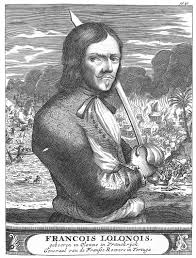Francois l'Olonnais was a French pirate who was active in the Caribbean during the 1660s. He became one of the most notorious pirates during the Golden Age of Pirates, even though he started from humble beginnings. Throughout his pirate career, he showed a knack for survival and resourcefulness.
Jump to:
Francois l'Olonnais Facts: Early Life
Francois l'Olonnais came to the New World as an indentured servant. It is not known how long he was an indentured servant, but by 1660, he was in the Caribbean as a free man and was hopping from island to island looking for work and eventually landed on the island of Saint-Domingue and decided on the life as a buccaneer.
Francois l'Olonnais sought after Spanish shipping in the Spanish West Indies and the Spanish Main but quickly met uncertainty. He and his crew ended up shipwrecked on near Campeche, and the Spanish sent a party of soldiers to capture him. His party was obliterated by the Spanish, but l'Olonnais survived by covering himself with blood and hiding under the dead bodies.
After the Spanish departed, l'Olonnais, with the assistance of some slaves, escaped and made his way to the island of Tortuga. A short time later, he and his crew held a town hostage, demanding a ransom from its Spanish rulers. The governor of Havana sent a ship to kill l'Olonnais' party. l'Olonnais captured and beheaded the entire raiding crew, saves one, whom he spared so that a message could be delivered to Havana: "I shall never henceforward give quarter to any Spaniard whatsoever."
Francois l'Olonnais Facts: Sacking of Maracaibo

After his near-death experience, Francis l'Olonnais returned to the pirate haven Tortuga, built another crew, and planned an attack on Maracaibo. What happened next would make the Spanish regret not finding and killing him when they had the chance.
In 1666, l'Olonnais sailed from Tortuga with a fleet of eight ships and a crew of 440 pirates to sack Maracaibo in what is modern-day Venezuela. En route, l'Olonnais crossed paths with a Spanish treasure ship, which he captured, along with its cargo of cocoa beans, gemstones, and more than 260,000 Spanish dollars.
Maracaibo was located in a defensive spot and was thought to be impregnable. L'Olonnais approached the city from an undefended land route and was able to sack the city within a few hours. When he arrived in the city, he did not find any residents or any gold because the residents had fled and had hidden their gold. He sent his men to find the residents, and when they did, l'Ollonnais tortured them until they told him where they had hidden their gold.
L'Olonnais tortured his victims, and it was one thing he was an expert in and his techniques included slicing portions of flesh off the victim with a sword, burning them alive, or tying knotted "woolding" (rope bound around a ship's mast to strengthen it) around the victim's head until their eyes were forced out.
Over the following two months, l'Olonnais and his men raped, pillaged, and eventually burned much of Maracaibo before moving to San Antonio de Gibraltar, Venezuela, on the eastern shore of Lake Maracaibo. Despite being outnumbered, the pirates slaughtered 500 soldiers of Gibraltar's garrison and held the city for ransom.
Despite the payment of the ransom, l'Olonnais continued to ransack the city, acquiring a total of 260,000 pieces of eight gems, silverware, silks, as well as a number of slaves.
Francois l'Olonnais Facts: A Fitting End
Word of his attack on Maracaibo and Gibraltar reached Tortuga, and l'Olonnais earned a reputation for his ferocity and cruelty. He was given the nickname "The Bane of Spain." Seven hundred pirates enlisted with him when he mounted his next expedition, this time to the Central American mainland.
In 1667, after pillaging Puerto Cavallo on the coast of Honduras, l'Olonnais was ambushed by a large force of Spanish soldiers while en route to San Pedro. Only narrowly escaping with his life, l'Olonnais captured two Spaniards. Exquemelin wrote:
" He drew his cutlass, and with it cut open the breast of one of those poor Spanish, and pulling out his heart with his sacrilegious hands, began to bite and gnaw it with his teeth, like a ravenous wolf, saying to the rest: I will serve you all alike if you show me not another way."
Horrified, the surviving Spaniard showed l'Olonnais a clear route to San Pedro. L'Olonnais and the few men still surviving were repelled and retreated back to their ship. They ran aground on a shoal on the coast of Darien, a province of Panama. Unable to dislodge their craft, they headed inland to find food. They were captured by the Kuna tribe in Darién. L'Olonnais was eaten by the natives. Exquemelin wrote that the natives:
"...tore him in pieces alive, throwing his body limb by limb into the fire and his ashes into the air; to the intent no trace nor memory might remain of such an infamous, inhuman creature".
It was a fitting end to his brutal life.
